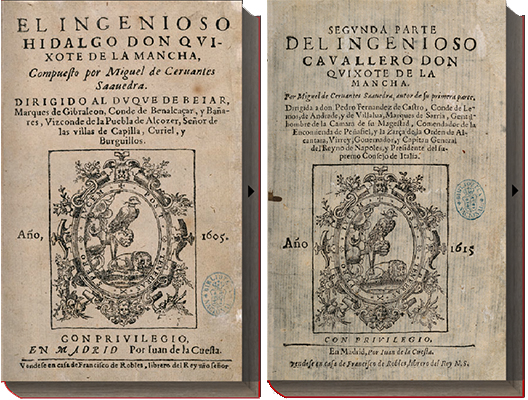32 Spanish (Europe)

If you walk down the street in many parts of the world and ask a stranger who fought the windmills, they would most probably answer Don Quixote. But they would not necessarily know the name of its author, Miguel de Cervantes Saavedra (1547-1616). This not-so-prolific dramaturge, poet and novelist has nonetheless had a major impact on the development of Western literature, influencing his English contemporary William Shakespeare, 19th-century French author Gustave Flaubert, and 20th-century Argentine author Jorge Luis Borges, just to name a few.
Cervantes did not come to prominence until much later in his life. His experiences as a soldier, a captive and a witness to the struggles of the Spanish empire shaped his distinctive oeuvre: a literary world of experimentation, as can be seen in his Exemplary Novels (1613), a world in which possibilities of reconciliation between conflictive individuals, ideals and desires remained hollow, inconclusive and, in many cases, without avail. Among other factors, what distinguishes Cervantes’ literary production is its unclassifiable nature, making it hard to try and fit the works in their presumed corresponding genre. One good example is his posthumous work The Travails of Persiles and Sigismunda (1616), where the Byzantine novel is mutilated to such an extent that, at points, it becomes almost unrecognizable.
Yet this unfittedness is most evident in Don Quixote (Part I published in 1605; Part II in 1615). The confusion between reality and fiction, the untrustworthiness of the multiple narrators, the intentional errors and misnomers, the three-dimensionalism of Don Quixote’s squire, Sancho, who has a love-hate relationship with his master, the utter destruction of the chivalric world, and the encounter with oppressed minorities are but some of the factors that have undoubtedly contributed to the sustained appeal of Don Quixote. The protagonist, an old man who “loses his mind” reading novels of chivalry, was, in Western literature, a pioneering self-proclaimed “hero.” He offers and imposes his help unto people who rarely take him seriously. Moreover, he only becomes popular, within his diegetic world, when in Part II he is defined by others as a caricature. This caricature remains dominant in the collective imaginary of readers, as can be seen, for example, in Picasso’s well-known depiction of the character.
Although most masterpieces ultimately attempt to challenge a comfortable experience of reading where we readily identify with fictitious characters; Don Quixote still manages to attract the empathy of its readers who may or may not closely identify with the knight-errant. Don Quixote is beaten up, both physically and metaphorically, yet his innocent, albeit selfish at times, intentions have ultimately won the hearts of a diverse audience over the centuries.
Today, the Spanish language, or Castilian as it is referred to in Europe, has grown from around 14 million speakers at the time of Cervantes to 477 million native speakers worldwide. It is now the second most used language for international communication and the most studied languages on the planet.1 At Berkeley, Spanish is one of the most widely used languages for scholarship after English, particularly in departments such as Anthropology, Comparative Literature, Ethnic Studies, Film & Media, Gender & Women’s Studies, History, Linguistics, Political Science, and Rhetoric. Interdisciplinary graduate programs in Latin American Studies, Medieval Studies, Romance Languages and Literature, and Medieval and Early Modern Studies also require reading of original texts in Spanish.
Nasser Meerkhan, Assistant Professor
Department of Near Eastern Studies & Department of Spanish & Portuguese
Source consulted:
- Elias, D. José Antonio. Atlas historico, geográfico y estadístico de España y sus posesiones de ultramar. Barcelona : Imprenta Hispana, 1848; Hernández Sánchez Barbara, Mario. “La población hispanoamericana y su distribución social en el siglo XVIII,” Revista de estudios políticos, no.78 (1954); López, Morales H, and El español: una lengua viva. Informe 2017. Madrid : Arco Libros, S.L. : El Instituto, 2017.
Author: Cervantes Saavedra, Miguel de, 1547-1616.
Imprint: En Madrid : por Iuan de la Cuesta, 1605, 1615.
Edition: 1st
Language: Spanish (Europe)
Language Family: Indo-European
Source: Biblioteca Nacional de España
URL: http://quijote.bne.es/libro.html (requires Flash)
Other online editions:
- El ingenioso hidalgo don Quixote de la Mancha / compuesto por Miguel de Ceruantes Saauedra. En Madrid : por Iuan de la Cuesta, 1605.
- Segunda parte del ingenioso cauallero don Quixote de la Mancha / por Miguel de Ceruantes Saauedra, autor de su primera parte. En Madrid : por Iuan de la Cuesta, 1615.
- The History of Don Quixote. Translated into English by J.W. Clark. Illustrated by Gustave Doré. New York, P.F. Collier, 1871 .
Select Print editions at Berkeley:
Considered to be the most translated work ever written, the Library has editions in French, German, Hebrew, Armenian, Quechua, and more. The earliest and best illustrated editions reside in The Bancroft Library.
- El ingenioso hidalgo don Quixote de la Mancha. Burgaillos. Published Impresso con licencia, en Valencia : En casa de Pedro Patricio Mey : A costa de Iusepe Ferrer mercader de libros, delante la Diputacion, 1605.
- Segunda parte del ingenioso cauallero don Quixote de la Mancha. En Valencia : En casa de Pedro Patricio Mey, junto a San Martin : A costa de Roque Sonzonio mercader de libros, 1616.
- Vida y hechos del ingenioso Hidalgo Don Quixote de la Mancha. Nueva edicion, corregida y ilustrada con 32 differentes estampas muy donosas, y apropriadas à la materia. Amberes, Por Henrico y Cornelio Verdussen, 1719.
- El ingenioso hidalgo Don Quijote de la Mancha / por Miguel de Cervantes Saavedra ; obra adornada de 125 estampas litográficas y publicada por Masse y Decaen, impresore litógrafos y editores, callejon de Santa Clara no 8. México : Impreso por Ignacio Cumplido, calle de los Rebeldes num. 2, 1842.
- Don Quixote / Miguel de Cervantes ; a new translation by Edith Grossman ; introduction by Harold Bloom. New York : Ecco, c2003.

